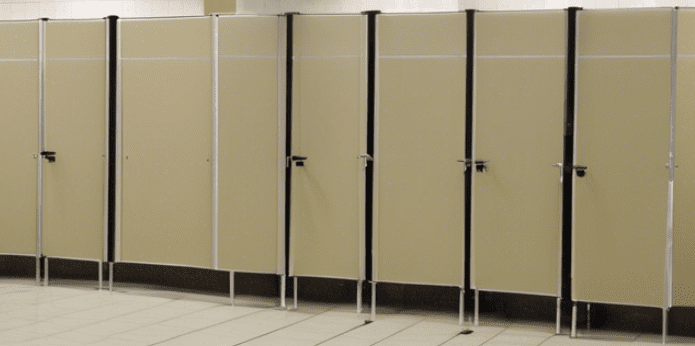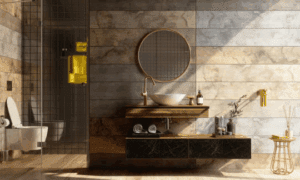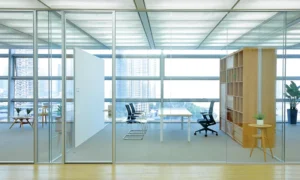Bathroom divider or simply the bathroom partitions design and installation must provide a harmonic balance of seclusion, accessibility, and durability. These components are essential to providing all users with a welcoming and inclusive bathroom experience. Create an ideal solution that meets a variety of demands. Let us explore the critical components of striking a balance between these three essential variables in this article.
Bathroom Partitions: Ensuring Privacy and Security
An integral part of any restroom design is privacy. The need for personal privacy in public areas has grown, and restroom partitions are essential to addressing this need.
It’s important to use lasting materials for bathroom partitions. Powder-coated steel or high-density polyethylene (HDPE) will be good. It will provide both a strong structure and a feeling of privacy and security.
Enhancing privacy is another benefit of incorporating technology into restroom design. While preserving personal privacy, smart partition systems with features like touchless entrance and exit choices help to create a sanitary atmosphere.
Accessibility: Catering to Diverse Needs
Moving on to the subject of accessibility, it is important to take into account the requirements of all people using the toilet, including those with disabilities. The Americans with Disabilities Act (ADA) establishes guidelines to guarantee that public areas, such as bathrooms, are universally accessible. It will help you create bathroom partitions that are compatible with local laws and legislature.
Wider doors and roomy interiors are examples of accessible features that guarantee people with mobility impairments may move around the room with ease. Furthermore, selecting the right materials is essential to building an accessible bathroom. For example, HDPE barriers not only provide durability but also help to create an atmosphere that is accessible.
Technology integration—such as touchless features—not only improves privacy but also meets the accessibility requirements of a wide range of users, demonstrating how these crucial elements are interdependent.
Durability: Withstanding Wear and Tear
Due to heavy foot traffic and moisture exposure, bathroom walls are always undergoing wear and tear. Choosing resources that are resilient to these difficulties is essential to guaranteeing a long-lasting fix.
HDPE is a popular option for long-lasting bathroom partitions because of its reputation for being resistant to impact, corrosion, and moisture. The lifespan of bathroom walls is also significantly influenced by the installation procedure itself. Expert installation lowers the possibility of damage or premature wear by ensuring the walls are placed firmly.
Moving from strength to appearance, it’s important to understand that bathroom dividers are not only practical components but also enhance the entire layout and atmosphere of the room.
Aesthetics: Unifying Form and Function
The selection of finishes, colors, and textures have great impact on the visual attractiveness of the restroom may be greatly impact. An area is cohesive and visually pleasant when partitions smoothly integrated with the overall design concept.
Furthermore, the design of your bathroom partitions must not jeopardize the essential elements of accessibility and privacy. Without compromising accessibility, a well-thought-out design might include seclusion elements like greater height or unusual arrangements.
Striking the Right Balance: Interconnected Considerations
It is important to carefully assess how each of the three crucial factors—privacy, accessibility, and durability—affects the others as you move between them. Finding the ideal balance requires more than simply making personal decisions; it also calls for a thorough approach to toilet design.
For example, when choosing privacy dividers, make sure the materials you choose meet accessibility standards and have the durability needed for long-term usage. Technology integration may improve accessibility and privacy in restroom design.
Maintenance and Sustainability: Ensuring Longevity and Responsibility
Regular upkeep prolongs the life of the walls while also preserving their visual appeal.
Selecting materials that are stain- and clean-resistant makes maintenance easier and guarantees that the restroom stays a welcoming and clean place for all users. Furthermore, a crucial component of responsible design is taking the environment into account while choosing the materials for partitions.
Sustainable materials meet the increased need for environmentally friendly solutions while also helping to create a better world. For example, HDPE bathroom partitions are completely recyclable and composed of recycled materials, making them not only strong but also eco-friendly.
Conclusion: Fostering Inclusive and Welcoming Spaces
In conclusion, designing bathroom walls that strike a perfect balance between durability, privacy, and accessibility is a complex task. It entails choosing materials carefully, following accessibility guidelines, paying close attention to how aesthetics blend in, and being environmentally conscious.
Through an understanding of the interdependence of these components and the use of creative thinking, designers and architects may create restroom environments that satisfy a range of user requirements while maintaining durability and aesthetic appeal. In addition to being a design challenge, balancing these aspects is a commitment to creating inclusive and inviting public places.



































